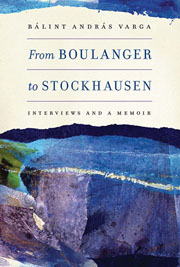Book contents
- Frontmatter
- Dedication
- Contents
- Foreword
- Acknowledgments
- Part One Interviews
- Part Two A Memoir
- Introduction
- Chapter 1 Ancestors
- Chapter 2 On Being Jewish
- Chapter 3 Growing Up in Postwar Socialist Hungary
- Chapter 4 Margit
- Chapter 5 Tapespondence
- Chapter 6 Birth and Demise of a (Counter)revolution: A Boy's-Eye View
- Chapter 7 Broadcasting 1
- Chapter 8 Broadcasting 2
- Chapter 9 Editio Musica Budapest
- Chapter 10 Interviewing: An Obsession
- Chapter 11 Ich war ein Berliner
- Chapter 12 Moving to Vienna
- Chapter 13 Universal Edition
- Chapter 14 Back Catalogue
- Chapter 15 The Psychology of Promotion
- Chapter 16 Farewell and After
- Notes in Retrospect
- Index
- Miscellaneous Endmatter
Introduction
from Part Two - A Memoir
Published online by Cambridge University Press: 05 January 2014
- Frontmatter
- Dedication
- Contents
- Foreword
- Acknowledgments
- Part One Interviews
- Part Two A Memoir
- Introduction
- Chapter 1 Ancestors
- Chapter 2 On Being Jewish
- Chapter 3 Growing Up in Postwar Socialist Hungary
- Chapter 4 Margit
- Chapter 5 Tapespondence
- Chapter 6 Birth and Demise of a (Counter)revolution: A Boy's-Eye View
- Chapter 7 Broadcasting 1
- Chapter 8 Broadcasting 2
- Chapter 9 Editio Musica Budapest
- Chapter 10 Interviewing: An Obsession
- Chapter 11 Ich war ein Berliner
- Chapter 12 Moving to Vienna
- Chapter 13 Universal Edition
- Chapter 14 Back Catalogue
- Chapter 15 The Psychology of Promotion
- Chapter 16 Farewell and After
- Notes in Retrospect
- Index
- Miscellaneous Endmatter
Summary
We are all contemporaries and heirs. Also, ancestors. Born into the present, we bore our way into the future and let the minutes fall away to become the past. As we try to establish a niche for ourselves, we come into contact with people who arrived before us. We grow older together for a time; gradually they depart and we find ourselves in the midst of younger generations.
In a memoir, you remember your own past and the men and women who formed it. You shed a shaft of light into the darkness, which deepens with the passage of time, and illuminate those figures, yourself among them, and situations you acted out in concert and in conflict. A memoir is stocktaking. You take stock of the way you made use of the time given to you; you know most of it is up and look back at your actions, as before a tribunal chaired by yourself. The real protagonist of any memoir is Time. It is the one given that is shared by us all. It is our common enemy: it eats away at our cells, transforms us, and kills us.
As a child, I used to imagine that by some miracle, I could make time go backward so that my mother would grow younger instead of older. Her health was fragile, she was always in pain of some sort, and I wanted to make her healthy and young.
- Type
- Chapter
- Information
- From Boulanger to StockhausenInterviews and a Memoir, pp. 267 - 268Publisher: Boydell & BrewerPrint publication year: 2013



